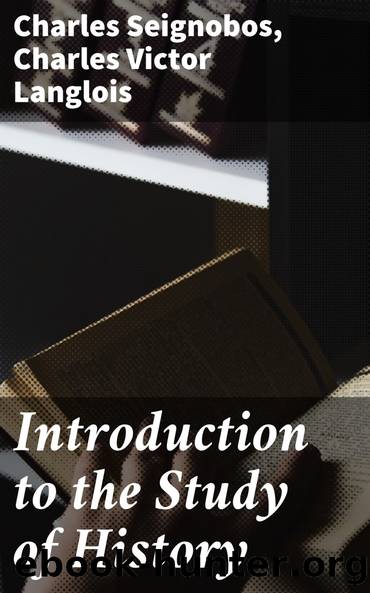Introduction to the Study of History by Charles Seignobos

Author:Charles Seignobos [Seignobos, Charles]
Language: fra
Format: epub
ISBN: 9780790553641
Google: 7SYBAAAAYAAJ
Publisher: H. Holt
Published: 1898-01-15T00:31:01+00:00
VI. Agreement between documents leads to conclusions which are not all of them definitive. In order to complete and rectify our conclusions we have still to study the harmony of the facts.
Several facts which, taken in isolation, are only imperfectly proved, may confirm each other in such a manner as to produce a collective certainty. The facts which the documents present in isolation have sometimes been in reality sufficiently near each other to be connected. Of this kind are the successive actions of the same man or of the same group of men, the habits of the same group at different epochs separated by short intervals, or of similar groups at the same epoch. It is no doubt possible that one of several analogous facts may be true and another false; the certainty of the first does not justify the categorical assertion of the second. But yet the harmony of several such facts, each proved imperfectly, yields a kind of certainty; the facts do not, in the strict sense of the word, prove, but they confirm[175] each other. The doubt which attached to each one of them disappears; we obtain that species of certainty which is produced by the interconnection of facts. Thus the comparison of conclusions which are separately doubtful yields a whole which is morally certain. In an itinerary of a sovereign, the days and the places confirm each other when they harmonize so as to form a coherent whole. An institution or a popular usage is established by the harmony of accounts, each of which is no more than probable, relating to different times and places.
This method is a difficult one to apply. The notion of harmony is a much vaguer one than that of agreement. We cannot assign any precise general rules for distinguishing facts which are sufficiently connected to form a whole, the harmony of whose parts would be conclusive; nor can we determine beforehand the duration and extent of that which may be taken to form a whole. Facts separated by half a century of time and a hundred leagues of space may confirm each other in such a way as to establish a popular usage (for example, among the ancient Germans); but they would prove nothing if they were taken from a heterogeneous society subject to rapid evolution (take, for example, French society in 1750, and again in 1800, in Alsace and in Provence). Here we have to study the relation between the facts. This brings us to the beginnings of historical construction; here is the transition from analytical to synthetic operations.
Download
This site does not store any files on its server. We only index and link to content provided by other sites. Please contact the content providers to delete copyright contents if any and email us, we'll remove relevant links or contents immediately.
Lean Lesson Planning: A practical approach to doing less and achieving more in the classroom (High Impact Teaching) by Mccrea Peps(1327)
Parent Talk by Chick Moorman(611)
The History of Work by Richard Donkin(596)
Fooled by Randomness: The Hidden Role of Chance in Life and in the Markets(536)
Big Questions in ELT by Scott Thornbury(486)
Cracking the Praxis Tests (Core Academic Skills + Subject Assessments + PLT Exams) by Princeton Review(485)
Engineering Graphics with AutoCAD 2020 by James D. Bethune(432)
Color Your Message: The Art of Digital Marketing and Social Media by Lisa Caprelli(395)
The Mediator's Toolkit by Gerry O'Sullivan(382)
My Growth Mindset Journal by Annie Brock(367)
Electrical Power Simplified by Dr. Prashobh Karunakaran(366)
The Side Hustle by Nick Loper(344)
ANIMAL ACTION by Unknown(340)
Becoming an Academic Writer: 50 Exercises for Paced, Productive, and Powerful Writing by Goodson Patricia(336)
Teaching Boys Who Struggle in School: Strategies That Turn Underachievers into Successful Learners by Cleveland Kathleen Palmer(332)
Contemporary Research in Adult and Lifelong Learning of Mathematics by Katherine Safford-Ramus & Jürgen Maaß & Evelyn Süss-Stepancik(331)
Designing a Prosocial Classroom by Christi Bergin(323)
The Models of Engaged Learning and Teaching by John Willison(323)
Educational Trauma by Lee-Anne Gray(322)
